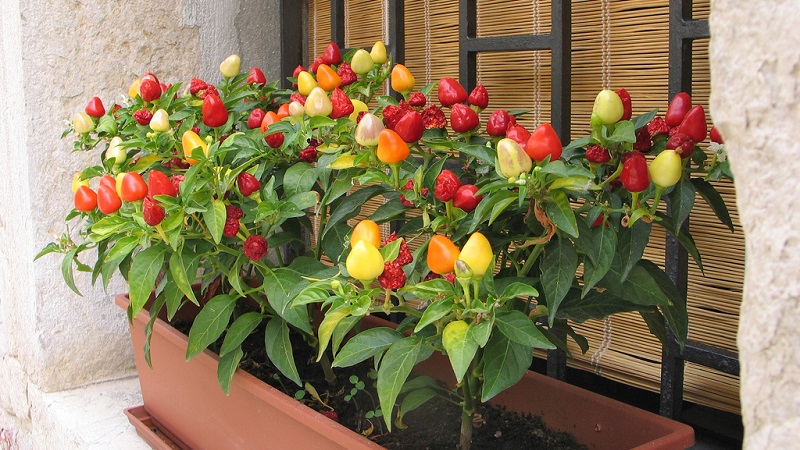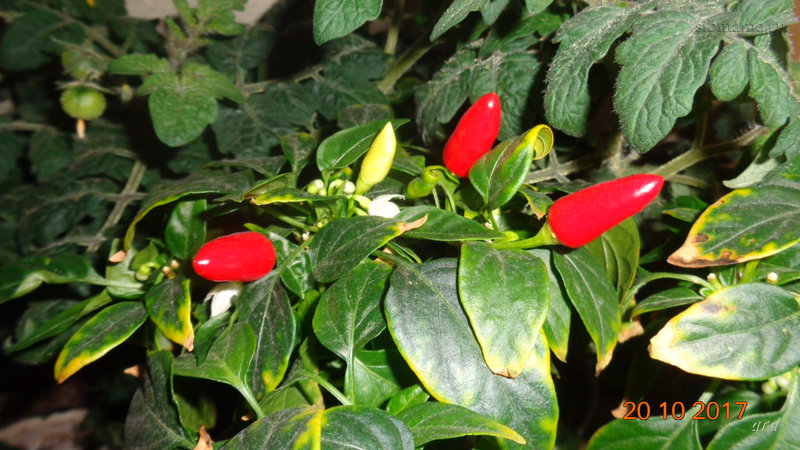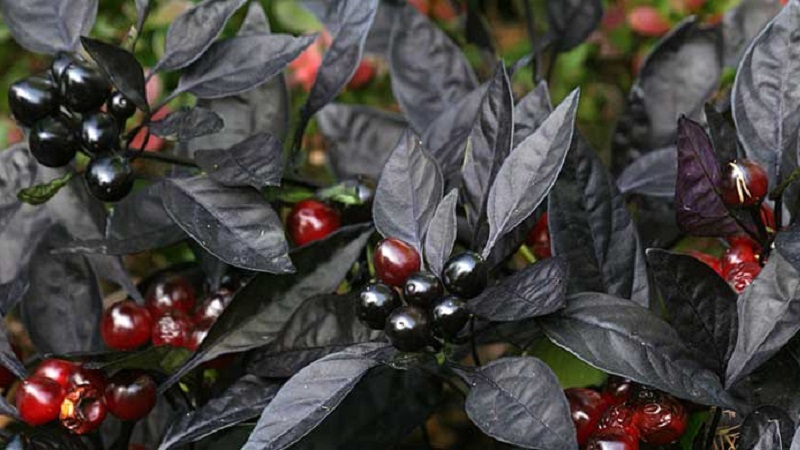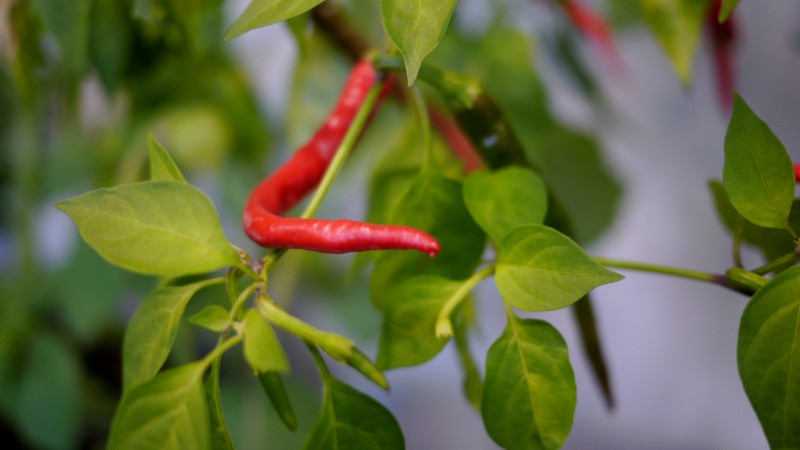How to choose a variety and properly grow indoor peppers on a windowsill or balcony
For self-growing fresh vegetables, it is not necessary to have a summer cottage. Indoor decorative peppers do not require special care and take up minimal space on the windowsill or balcony. If you follow the recommendations of experts, then planting and growing this plant will not cause difficulties.
The content of the article
What is indoor pepper
Indoor pepper is a perennial, unpretentious plant that is grown both in open and closed ground, as well as at home on a windowsill. Most varieties are used for food as spices and a source of vitamins.
Feature and Description
Indoor plant is compact in size. The branchy culture reaches a height of 20 to 50 cm. The bushes have a lot of leaves and fruits. In the summer, the pepper is taken out on the balcony windowsill, if possible, transplanted into the greenhouse. Before the temperature drops, the pepper is transplanted back into the pot.

Indoor peppers that can be grown on a windowsill
Indoor peppers not only yield crops, but are also interesting for their attractive appearance. Each variety has different shades, shape, structure of leaves and fruits, as well as the appearance of flowers.
Many housewives grow this plant in their apartment solely for interior decoration. The right variety will perfectly complement the design of your kitchen or room.
Decorative
Depending on the variety, the shape, color and size of vegetables differ. Some ornamental plants have fruits that are unsuitable for human consumption. These peppers have poisonous roots and tops.
Popular varieties:
- Goldfinder. The fruits of this plant are inedible. The variety is grown to decorate the house. The vegetables have a beautiful bright yellow color.
- Clown... The bush grows up to 35 cm. The plant has round or slightly elongated fruits of yellow, orange or red color. Pepper gives abundant fruiting in bright sun for 2-3 months. The fruits are inedible.
- Indoor paprika... It is an annual plant that has sweet, bright red fruits. After collecting the peppers, the bush dries up. The variety grows from 35 to 50 cm.
- Salute. Shrub pepper has a height of 15 to 20 cm. The culture grows well in the apartment. The fruits are used for seasoning and preservation.
- Jellyfish. An unusual variety of ornamental pepper. The plant is covered with beautiful fruits that reach 5 cm in length. It received this name due to the similarity of the fruit with the tentacles of the jellyfish. The culture grows up to 25 cm in height. The fruits of this variety have a very spicy taste.
- Black Pearl. The plant is quite unusual, as over time it changes its color from green to black. The fruits are rounded, slightly elongated, also black, but when ripe, they are painted in a dark red hue.
- Troll... Spreading bush, reaches a height of 30-40 cm. As it ripens the fruits change color from green to purple, and when fully ripe they turn red. Peppers are edible, have a pungent burning taste - they are used for conservation, drying and powder preparation.
Edible
For growing indoor peppers at home, varieties with small leaves and a weak root system or unpretentious hybrid crops are most often chosen. Perennial plants with sharp tastes like fruit. They have good characteristics and produce excellent fruit in confined spaces.

The most popular varieties of peppers:
- Aladdin... At home, the bush reaches 50 cm. This is an early plant, abundant and long-term fruiting. The small pods are cone-shaped. As they ripen, the aromatic and pungent fruits change their color. Ripe peppers are red in color.
- Twinkle... The fruits of indoor peppers ripen in an average time - from 115 to 120 days. The plant is medium-sized, branched. One pod weighs 35-45 g, has a bright red color and has a pungent taste.
- Explosive amber... The culture is well suited for growing on a windowsill due to the compactness of the bush. The plant reaches a height of no more than 30 cm. Fruits ripen quickly, their length reaches 2.5 cm. As they ripen, the purple pods turn pale to a yellowish tint, then turn orange, turn pink and complete their development in a dark red color. Ripe fruits have a fruity flavor, but they do not lose their pungency.
- Poinsettia. The culture grows up to 35 cm, has many oblong leaves. The fruits reach 7.5 cm in length and have a conical shape with a bend at the tip. The variety is early ripening, reaching biological maturity in 70–80 days. The pods change color from milky to red as they ripen. Ripe fruits have a medium-pungent taste.
When buying ornamental pepper seed material, carefully study the characteristics of the variety, try to purchase seeds in gardening stores and pay attention to the photo of the package. Often, instead of home culture, they sell grains of ordinary hot peppers, which are not intended for indoor cultivation.
On a note. To collect the seeds, wait until the fruits are fully ripe. Then they are well dried, crushed and seeds are selected. The grains remain viable for 3-4 years.
Space and space requirements
Pepper loves an abundance of light, warmth and moisture. The culture grows well on windows and balconies that face south and southeast... Daytime air temperature should be at around + 22-26 ° C, and at night within + 16-19 ° C. If these values drop to + 13 ° C, the plants will die. They are also negatively affected by drafts. Growing pepper in winter on the balcony is allowed if it is well insulated or additionally heated.
In winter, daylight hours are reduced, so additional lighting from fluorescent lamps is evenly installed over the plants. They are fixed at a distance of 30-50 cm from the tops of the bushes. To extend daylight hours, the light is turned on before dawn and after sunset. Plants need lighting for 10-12 hours.

How to grow correctly
Sowing of indoor peppers is done at any suitable time of the year. If the planting was carried out in August-September, then the harvest will ripen around November-December.
For planting pepper seeds, the soil mixture is purchased at a gardening store or you prepare a nutrient substrate yourself. To do this, mix the following components:
- river sand, perlite or vermiculite (1 part);
- peat (2 parts).
Before sowing seeds, the soil for plants must be disinfected by sprinkling with preparations "Biofungicide", "Fitosporin" or a weak solution of potassium permanganate. This procedure is carried out to prevent the development of fungal diseases. Some people pre-calcine the soil in the oven.
Pepper grains are germinated in humid conditions before planting. For this, the seeds are wrapped in a damp cotton cloth. To keep the moisture longer, the saucer with seeds is covered with a lid.
For several days, the container with grains is placed in a dark and warm place with an air temperature of + 25-27 ° C. The seeds are kept moist and periodically inspected for sprouts. When the seeds hatch, they are planted in prepared soil.
Growing instructions
Those who have been growing indoor peppers for a long time plant sprouted seeds from late February to early March... The day before sowing, the soil is well moistened. After this time, the grains are deepened into the soil by 1 cm and the container is covered with transparent glass or foil. Next, the container is placed in a warm, dark place until shoots appear.
When the seedlings have 3-4 leaves, they are transplanted into separate pots. Choose a beautiful container with a volume of about 3-5 liters. At the bottom of the container, there must be holes to drain excess water and a drainage layer of 2-3 cm.
The quality of watering is of great importance for pepper. Moisturizing is carried out not as abundantly as regularly. To do this, use settled water at room temperature (not lower than 20 ° C). Experienced growers water mature shrubs when the foliage becomes slightly lethargic. However, when the plant begins to bloom and bear fruit, this is not allowed.

For your information... Some varieties of hot peppers especially need humidification of the air, so they are not only regularly moistened, but also sprayed on the bushes themselves.
Fertilize the culture every 10-14 days, mainly in the spring and summer. To do this, use complex mineral fertilizing, for example, "Nitrofoska", "Solution", "Kemira-Lux" or "Kemira-universal". For preparation, one teaspoon of the drug is stirred in 5 liters of water. Before fertilization, the plants are watered, and in a pot, and not in a pan.
For year-round fruiting of pepper, the plant is kept at a daytime temperature of + 22-24 ° C, and at night at + 17-19 ° C. So that the bushes do not suffer from overheating on the windowsill in winter, they reduce the power of the heater.
In the spring, the peppers are transplanted into new soil. With the onset of warm weather, the culture is taken out onto the balcony and placed where there are no drafts. Some growers plant indoor peppers in the greenhouse, but they do not do this if its sweet brother is growing there. In another case, the plants are pollinated, and instead of sweet pepper, bitter, albeit large, will turn out.
The nuances of home care
When pepper sprouts appear, the container with the seedlings is moved to the windowsill and the air temperature is lowered to + 20-22 ° C. The film or glass is removed and illuminated up to 12 o'clock using lamps.
During transplantation, pinching of the main root is not carried out, since the culture does not tolerate this event well and slows down in growth.
For the first time, the seeds are planted in disposable cups with a diameter of no more than 5 cm and a height of up to 10 cm. Further, the transplant is carried out as the culture grows. Plants are moved to another container with a larger diameter when the roots begin to crowded. Pots for adult shrubs are chosen with a height of 15-25 cm and a diameter of about 20-30 cm.
Indoor pepper is picky about soil moisture and does not like cold water. Plants are watered sparingly, with settled room water, as the topsoil dries out, but allowing moisture to be absorbed from the pan. If water remains in the pan after 30 minutes, it is poured out.
On a note. The higher the air temperature in the room, the more often the soil is watered.
Indoor hot peppers are not pinched, and in order for the plant to branch better, pinch its top.
Diseases and pests

Hot peppers, like ordinary peppers, are susceptible to fungal diseases and various pests. Therefore, it is worth finding out in advance what problems the plants may have and how to deal with them.
- Spider mite... Due to the intervention of this pest, the growth of the culture stops, the leaves begin to curl, on which the tick leaves its web. They destroy it by spraying the plants with Aktellik, but at home, the biological products Bitoxibacillin or Fitoverm are best suited.
- Aphid... It eats young shoots of culture. They get rid of aphids by treating the bushes with Fitoverm or Bitoxybacillin biological products.
- Blackleg. This is a fungal disease that affects seedlings. The stem at the base of the shoots becomes thin and black.The disease appears due to excessive moisture in the soil or a lack of lighting - this leads to the death of young plants. To prevent the disease, water the soil and spray the sprouts with the fungicide "Previkur".
Important! On the packaging of each drug against diseases and pests, a waiting period is indicated, after which you can eat the fruits.
Also tobacco is good for pest control. It is simply poured onto the plant itself and the surface of the soil in a container.
Where to apply
Hot peppers are widely used to prepare savory dishes. The fruits are great for preserving and making various sauces. Hot pepper increases appetite, goes well with many dishes, especially the first.
It is also used in medicine. Medicinal tinctures are made from it, which are used against indigestion, sciatica and neuralgia. Hot peppers have been shown to lower blood pressure.
On a note. If dried fruits without seeds are ground in a coffee grinder, you get a natural hot seasoning.
Conclusion
If you love indoor plants, then growing ornamental peppers will definitely captivate you. This plant does not require much care and will thank you with vitamin fruits all year round. Besides, it will decorate the interior of the house.